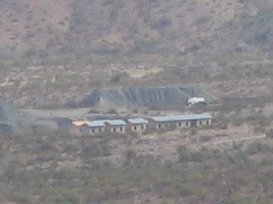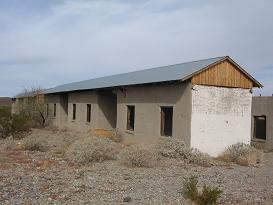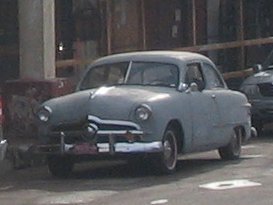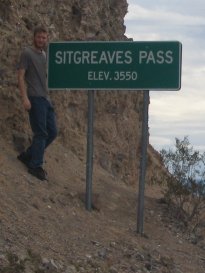

Swansea is an abandoned copper mine and ghost town in the Buckskin Mountain area of LaPaz County. It’s a unique, large and interesting site that can be accessed without 4-wheel drive. Bring plenty of food and water because the mountainous desert area surrounding Swansea is in the middle of nowhere with no services or signs of civilization, and cell phones don’t work there either. Even though its location is remote with limited access, the place is no secret and it’s a popular destination. The best time to go is in winter when the weather is mild. Elevation: 1,280 ft.
The road to Swansea starts in Bouse, AZ at the Camp Bouse memorial on Hwy. 72. We turned right on Main Street, went past an assay museum, and turned left on Rayder Ave. which turned into Swansea Rd. Just outside Bouse there is a fork in the road at which point you will want to bear left. After that there are three main landmarks. You will cross the Central Arizona Project (CAP) Canal, then you will come to a point called Midway that has an interpretive kiosk. Midway used to be a water stop on the railroad line that connected Bouse and Swansea. From there you will veer left, and after that you will come to a four-way stop sign. Turn right to get to Swansea. Just before arriving in Swansea, if you use your imagination you will see a dark brown mountain shaped like a gorilla’s head, which we called Gorilla Peak. Drive around the back of that mountain and you will soon see the ghost town. The curvy mountain road going down to Swansea is a little narrow and scary, but several RVs had made it down there.
Originally a 21-mile buckboard ride from Bouse, Swansea was the headquarters for the Clara Consolidated Gold and Copper Mining company. The town was named after Swansea in South Wales, UK where the original stakeholder George Mitchell came from, and where most of its copper was shipped. The Swansea site covers an extensive area. There are a number of buildings still standing, mine shafts, a main street, a railroad station, and ruins of the smelter. The mine was active periodically from 1908 to 1949. It produced 27,000,000 pounds of copper. The ore was shipped by railroad to the Colorado River, transferred onto river steamers headed to the Gulf of California, then by freighters around Cape Horn to Swansea, Wales.
Swansea's post office was established on March 25, 1909 and was discontinued on June 28, 1924. During its heyday, Swansea’s population grew to a total of 750 residents, mostly men. It was not as large as Jerome, Oatman or Bisbee. Swansea had an electric light company, auto dealer, lumber company, two cemeteries, a saloon, moving picture house, general store, insurance agent, justice of the peace, “Swansea Times” newspaper, railroad station, Mitchell’s two-story residence, and of course the mine and smelter. Swansea’s population declined when copper prices dropped after WWI. In 1929, the American Smelting and Refining Company rebuilt much of the town. However, due to the Great Depression the mine was closed and Swansea became a ghost town in 1937, although periodic mining did continue until 1949.
Imagine our surprise when we came around the mountain and got our first glimpse of Swansea. Instead of dilapidated shacks, we observed sunlight reflecting off shiny metal roofs! As we drove closer, we saw that the rafters were built of fresh lumber. Hmm, was this a ghost town or a construction site? Both I guess, because the row of old miner’s shacks are in the process of being restored. The roofs had caved in over the years, and without any protection from the elements, the adobe and stucco walls would start wearing away. The old wooden floor boards are also being replaced. We got to see one shack that was pretty well remodeled, but also got to see some that still had the original wood floors and ceiling timbers remaining. I’m glad to see that these old structures are being preserved for future generations to explore. I wonder how the miner’s shacks managed to last as long as they did? Because all that’s left of the other structures are cement foundations or ruins. How can the brick walls of a smelter fall down anyway? And there’s nothing left of the two town cemeteries either because the graves have all been dug up. What’s the deal with that? Don’t people have any respect for the past, not even for the dead?
The Swansea site is much larger than it first appears once you learn about the area. The Bureau of Land Management provides brochures that enable visitors to understand and appreciate the site. There is an information kiosk with a brochure holder where you first enter into Swansea, but it was empty when we arrived. You may be able to get a brochure in advance at the BLM Field Office in Lake Havasu City. We found and printed out an informative brochure and map of Swansea online:
http://personal.riverusers.com/~fw/AGT/swansea.htm.
You can view some more beautiful photos of Swansea here:
http://www.ghosttowngallery.com/htme/swansea.htmLabels: Bouse, copper mine, ghost town, Swansea



